EST204 - ICT in Education: Integration Plan, Applications & Pedagogy
VerifiedAdded on 2023/04/22
|10
|2136
|375
Report
AI Summary
This report discusses the impact of Information and Communication Technology (ICT) within the education sector, emphasizing its integration into teaching and learning. It outlines a project management approach for implementing ICT tools, including feasibility analysis, schedule planning, and training. The report highlights the importance of infrastructure, hardware, and software in creating a constructive learning environment. Examples of ICT applications, such as interactive whiteboards, cloud computing, and virtual reality, are provided to demonstrate their benefits in enhancing student engagement and knowledge acquisition. The report concludes that ICT integration can lead to significant improvements in educational processes, offering ease of operations, complexity reduction, and enhanced accuracy.
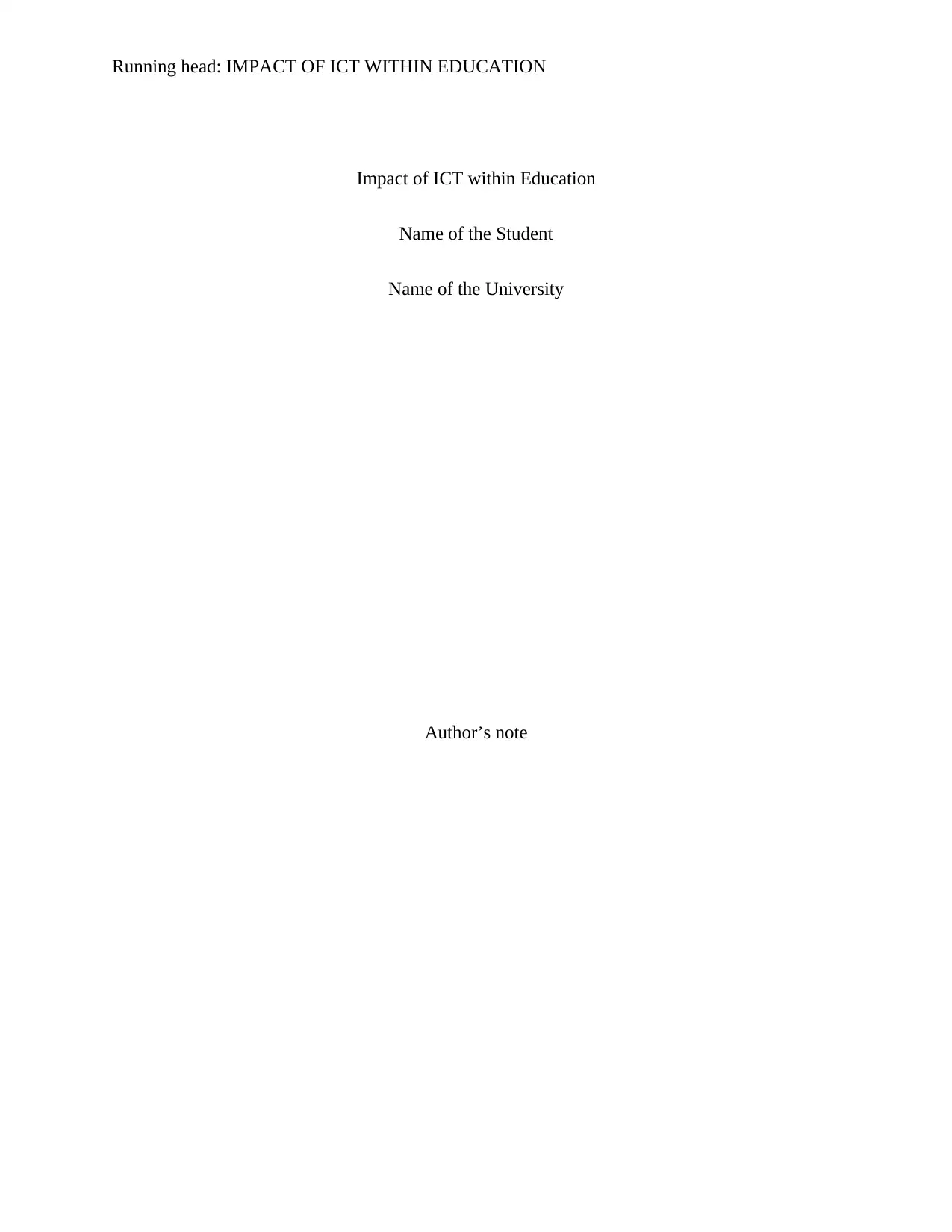
Running head: IMPACT OF ICT WITHIN EDUCATION
Impact of ICT within Education
Name of the Student
Name of the University
Author’s note
Impact of ICT within Education
Name of the Student
Name of the University
Author’s note
Paraphrase This Document
Need a fresh take? Get an instant paraphrase of this document with our AI Paraphraser
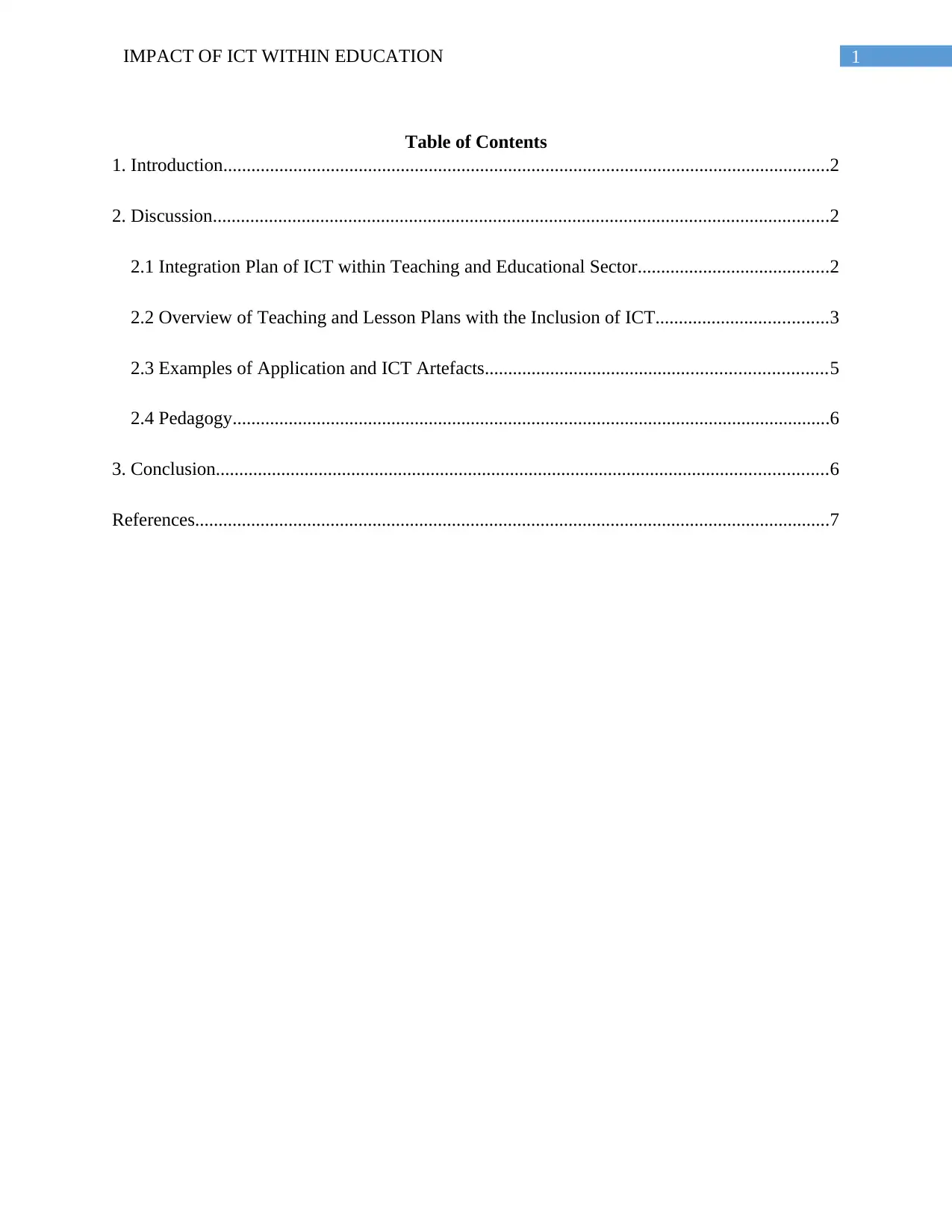
1IMPACT OF ICT WITHIN EDUCATION
Table of Contents
1. Introduction..................................................................................................................................2
2. Discussion....................................................................................................................................2
2.1 Integration Plan of ICT within Teaching and Educational Sector.........................................2
2.2 Overview of Teaching and Lesson Plans with the Inclusion of ICT.....................................3
2.3 Examples of Application and ICT Artefacts.........................................................................5
2.4 Pedagogy................................................................................................................................6
3. Conclusion...................................................................................................................................6
References........................................................................................................................................7
Table of Contents
1. Introduction..................................................................................................................................2
2. Discussion....................................................................................................................................2
2.1 Integration Plan of ICT within Teaching and Educational Sector.........................................2
2.2 Overview of Teaching and Lesson Plans with the Inclusion of ICT.....................................3
2.3 Examples of Application and ICT Artefacts.........................................................................5
2.4 Pedagogy................................................................................................................................6
3. Conclusion...................................................................................................................................6
References........................................................................................................................................7
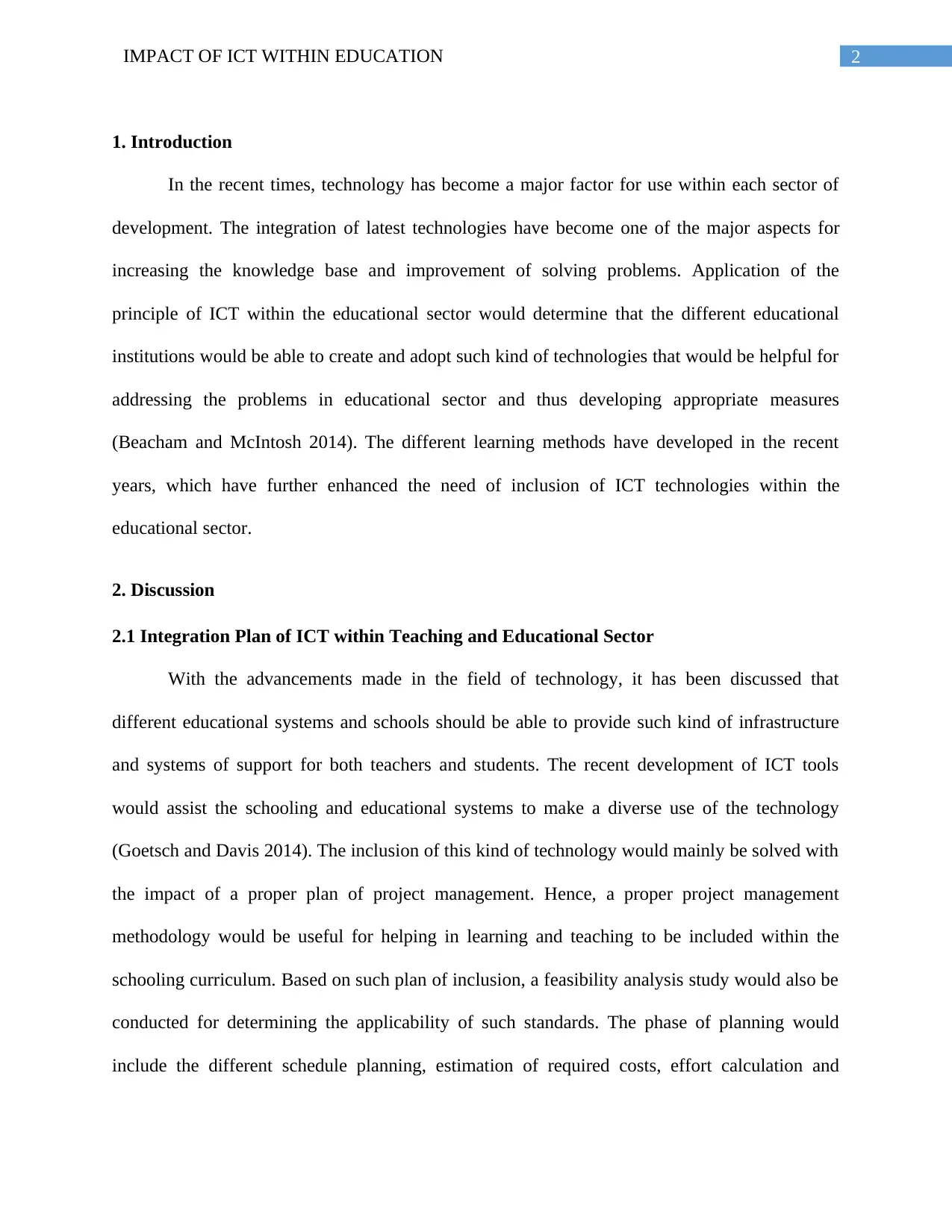
2IMPACT OF ICT WITHIN EDUCATION
1. Introduction
In the recent times, technology has become a major factor for use within each sector of
development. The integration of latest technologies have become one of the major aspects for
increasing the knowledge base and improvement of solving problems. Application of the
principle of ICT within the educational sector would determine that the different educational
institutions would be able to create and adopt such kind of technologies that would be helpful for
addressing the problems in educational sector and thus developing appropriate measures
(Beacham and McIntosh 2014). The different learning methods have developed in the recent
years, which have further enhanced the need of inclusion of ICT technologies within the
educational sector.
2. Discussion
2.1 Integration Plan of ICT within Teaching and Educational Sector
With the advancements made in the field of technology, it has been discussed that
different educational systems and schools should be able to provide such kind of infrastructure
and systems of support for both teachers and students. The recent development of ICT tools
would assist the schooling and educational systems to make a diverse use of the technology
(Goetsch and Davis 2014). The inclusion of this kind of technology would mainly be solved with
the impact of a proper plan of project management. Hence, a proper project management
methodology would be useful for helping in learning and teaching to be included within the
schooling curriculum. Based on such plan of inclusion, a feasibility analysis study would also be
conducted for determining the applicability of such standards. The phase of planning would
include the different schedule planning, estimation of required costs, effort calculation and
1. Introduction
In the recent times, technology has become a major factor for use within each sector of
development. The integration of latest technologies have become one of the major aspects for
increasing the knowledge base and improvement of solving problems. Application of the
principle of ICT within the educational sector would determine that the different educational
institutions would be able to create and adopt such kind of technologies that would be helpful for
addressing the problems in educational sector and thus developing appropriate measures
(Beacham and McIntosh 2014). The different learning methods have developed in the recent
years, which have further enhanced the need of inclusion of ICT technologies within the
educational sector.
2. Discussion
2.1 Integration Plan of ICT within Teaching and Educational Sector
With the advancements made in the field of technology, it has been discussed that
different educational systems and schools should be able to provide such kind of infrastructure
and systems of support for both teachers and students. The recent development of ICT tools
would assist the schooling and educational systems to make a diverse use of the technology
(Goetsch and Davis 2014). The inclusion of this kind of technology would mainly be solved with
the impact of a proper plan of project management. Hence, a proper project management
methodology would be useful for helping in learning and teaching to be included within the
schooling curriculum. Based on such plan of inclusion, a feasibility analysis study would also be
conducted for determining the applicability of such standards. The phase of planning would
include the different schedule planning, estimation of required costs, effort calculation and
⊘ This is a preview!⊘
Do you want full access?
Subscribe today to unlock all pages.

Trusted by 1+ million students worldwide
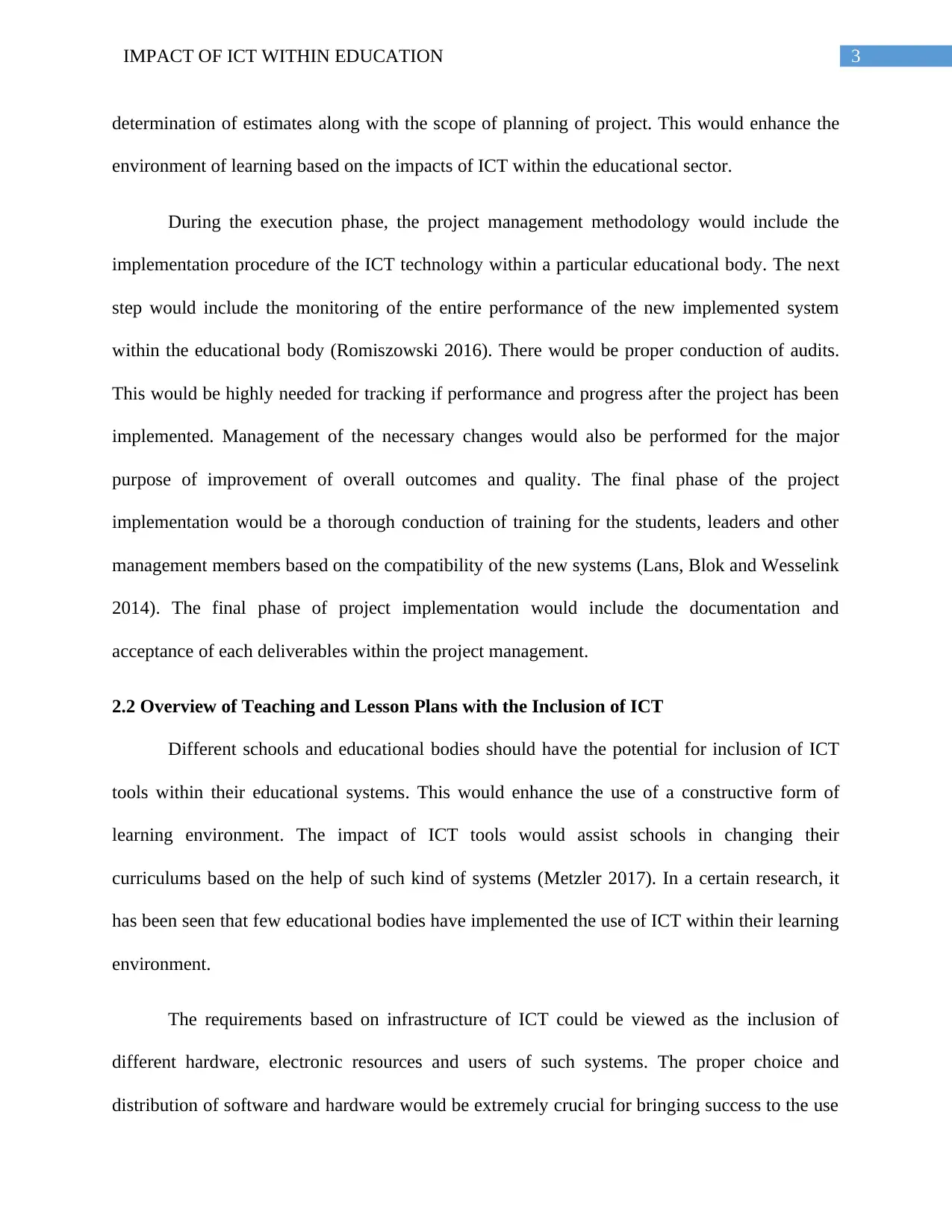
3IMPACT OF ICT WITHIN EDUCATION
determination of estimates along with the scope of planning of project. This would enhance the
environment of learning based on the impacts of ICT within the educational sector.
During the execution phase, the project management methodology would include the
implementation procedure of the ICT technology within a particular educational body. The next
step would include the monitoring of the entire performance of the new implemented system
within the educational body (Romiszowski 2016). There would be proper conduction of audits.
This would be highly needed for tracking if performance and progress after the project has been
implemented. Management of the necessary changes would also be performed for the major
purpose of improvement of overall outcomes and quality. The final phase of the project
implementation would be a thorough conduction of training for the students, leaders and other
management members based on the compatibility of the new systems (Lans, Blok and Wesselink
2014). The final phase of project implementation would include the documentation and
acceptance of each deliverables within the project management.
2.2 Overview of Teaching and Lesson Plans with the Inclusion of ICT
Different schools and educational bodies should have the potential for inclusion of ICT
tools within their educational systems. This would enhance the use of a constructive form of
learning environment. The impact of ICT tools would assist schools in changing their
curriculums based on the help of such kind of systems (Metzler 2017). In a certain research, it
has been seen that few educational bodies have implemented the use of ICT within their learning
environment.
The requirements based on infrastructure of ICT could be viewed as the inclusion of
different hardware, electronic resources and users of such systems. The proper choice and
distribution of software and hardware would be extremely crucial for bringing success to the use
determination of estimates along with the scope of planning of project. This would enhance the
environment of learning based on the impacts of ICT within the educational sector.
During the execution phase, the project management methodology would include the
implementation procedure of the ICT technology within a particular educational body. The next
step would include the monitoring of the entire performance of the new implemented system
within the educational body (Romiszowski 2016). There would be proper conduction of audits.
This would be highly needed for tracking if performance and progress after the project has been
implemented. Management of the necessary changes would also be performed for the major
purpose of improvement of overall outcomes and quality. The final phase of the project
implementation would be a thorough conduction of training for the students, leaders and other
management members based on the compatibility of the new systems (Lans, Blok and Wesselink
2014). The final phase of project implementation would include the documentation and
acceptance of each deliverables within the project management.
2.2 Overview of Teaching and Lesson Plans with the Inclusion of ICT
Different schools and educational bodies should have the potential for inclusion of ICT
tools within their educational systems. This would enhance the use of a constructive form of
learning environment. The impact of ICT tools would assist schools in changing their
curriculums based on the help of such kind of systems (Metzler 2017). In a certain research, it
has been seen that few educational bodies have implemented the use of ICT within their learning
environment.
The requirements based on infrastructure of ICT could be viewed as the inclusion of
different hardware, electronic resources and users of such systems. The proper choice and
distribution of software and hardware would be extremely crucial for bringing success to the use
Paraphrase This Document
Need a fresh take? Get an instant paraphrase of this document with our AI Paraphraser
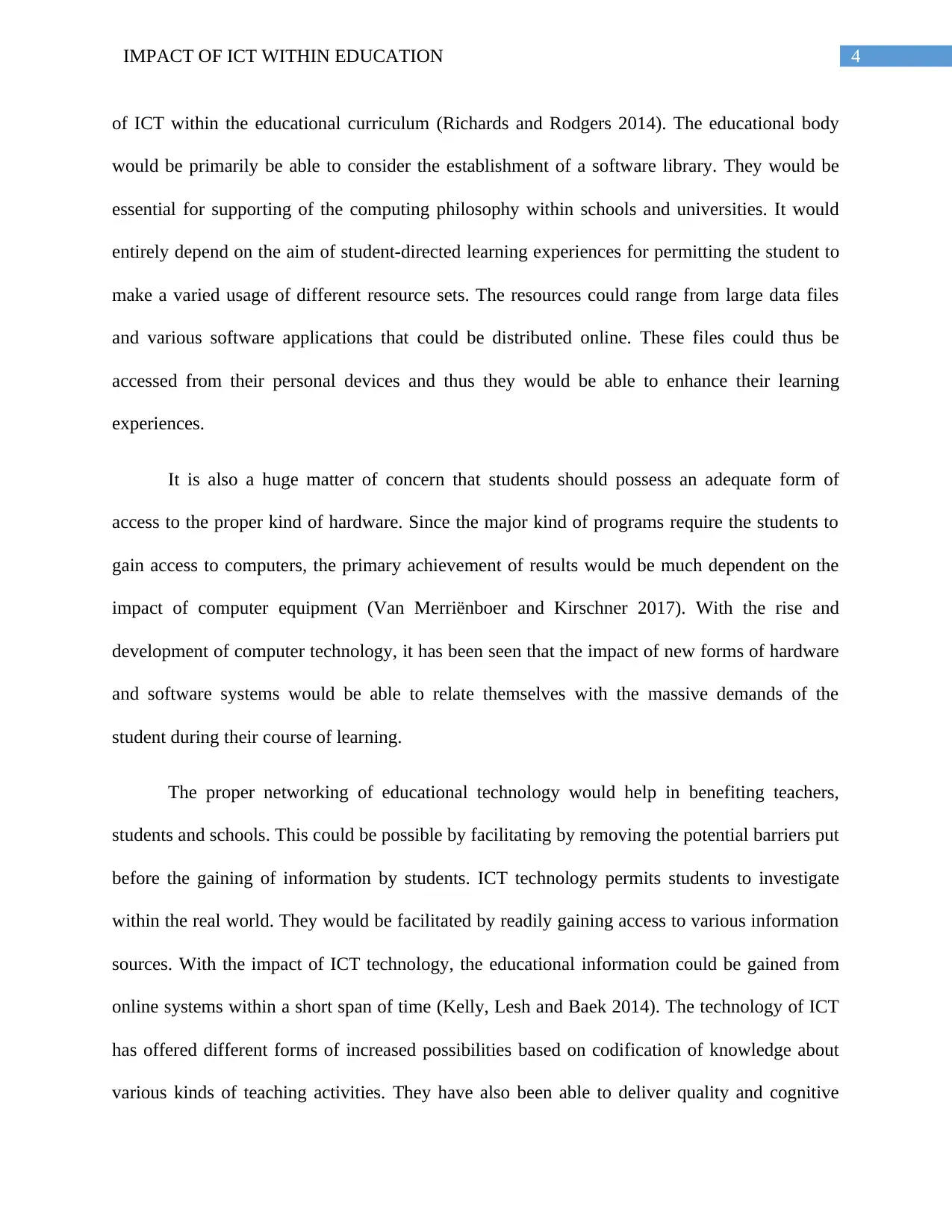
4IMPACT OF ICT WITHIN EDUCATION
of ICT within the educational curriculum (Richards and Rodgers 2014). The educational body
would be primarily be able to consider the establishment of a software library. They would be
essential for supporting of the computing philosophy within schools and universities. It would
entirely depend on the aim of student-directed learning experiences for permitting the student to
make a varied usage of different resource sets. The resources could range from large data files
and various software applications that could be distributed online. These files could thus be
accessed from their personal devices and thus they would be able to enhance their learning
experiences.
It is also a huge matter of concern that students should possess an adequate form of
access to the proper kind of hardware. Since the major kind of programs require the students to
gain access to computers, the primary achievement of results would be much dependent on the
impact of computer equipment (Van Merriënboer and Kirschner 2017). With the rise and
development of computer technology, it has been seen that the impact of new forms of hardware
and software systems would be able to relate themselves with the massive demands of the
student during their course of learning.
The proper networking of educational technology would help in benefiting teachers,
students and schools. This could be possible by facilitating by removing the potential barriers put
before the gaining of information by students. ICT technology permits students to investigate
within the real world. They would be facilitated by readily gaining access to various information
sources. With the impact of ICT technology, the educational information could be gained from
online systems within a short span of time (Kelly, Lesh and Baek 2014). The technology of ICT
has offered different forms of increased possibilities based on codification of knowledge about
various kinds of teaching activities. They have also been able to deliver quality and cognitive
of ICT within the educational curriculum (Richards and Rodgers 2014). The educational body
would be primarily be able to consider the establishment of a software library. They would be
essential for supporting of the computing philosophy within schools and universities. It would
entirely depend on the aim of student-directed learning experiences for permitting the student to
make a varied usage of different resource sets. The resources could range from large data files
and various software applications that could be distributed online. These files could thus be
accessed from their personal devices and thus they would be able to enhance their learning
experiences.
It is also a huge matter of concern that students should possess an adequate form of
access to the proper kind of hardware. Since the major kind of programs require the students to
gain access to computers, the primary achievement of results would be much dependent on the
impact of computer equipment (Van Merriënboer and Kirschner 2017). With the rise and
development of computer technology, it has been seen that the impact of new forms of hardware
and software systems would be able to relate themselves with the massive demands of the
student during their course of learning.
The proper networking of educational technology would help in benefiting teachers,
students and schools. This could be possible by facilitating by removing the potential barriers put
before the gaining of information by students. ICT technology permits students to investigate
within the real world. They would be facilitated by readily gaining access to various information
sources. With the impact of ICT technology, the educational information could be gained from
online systems within a short span of time (Kelly, Lesh and Baek 2014). The technology of ICT
has offered different forms of increased possibilities based on codification of knowledge about
various kinds of teaching activities. They have also been able to deliver quality and cognitive
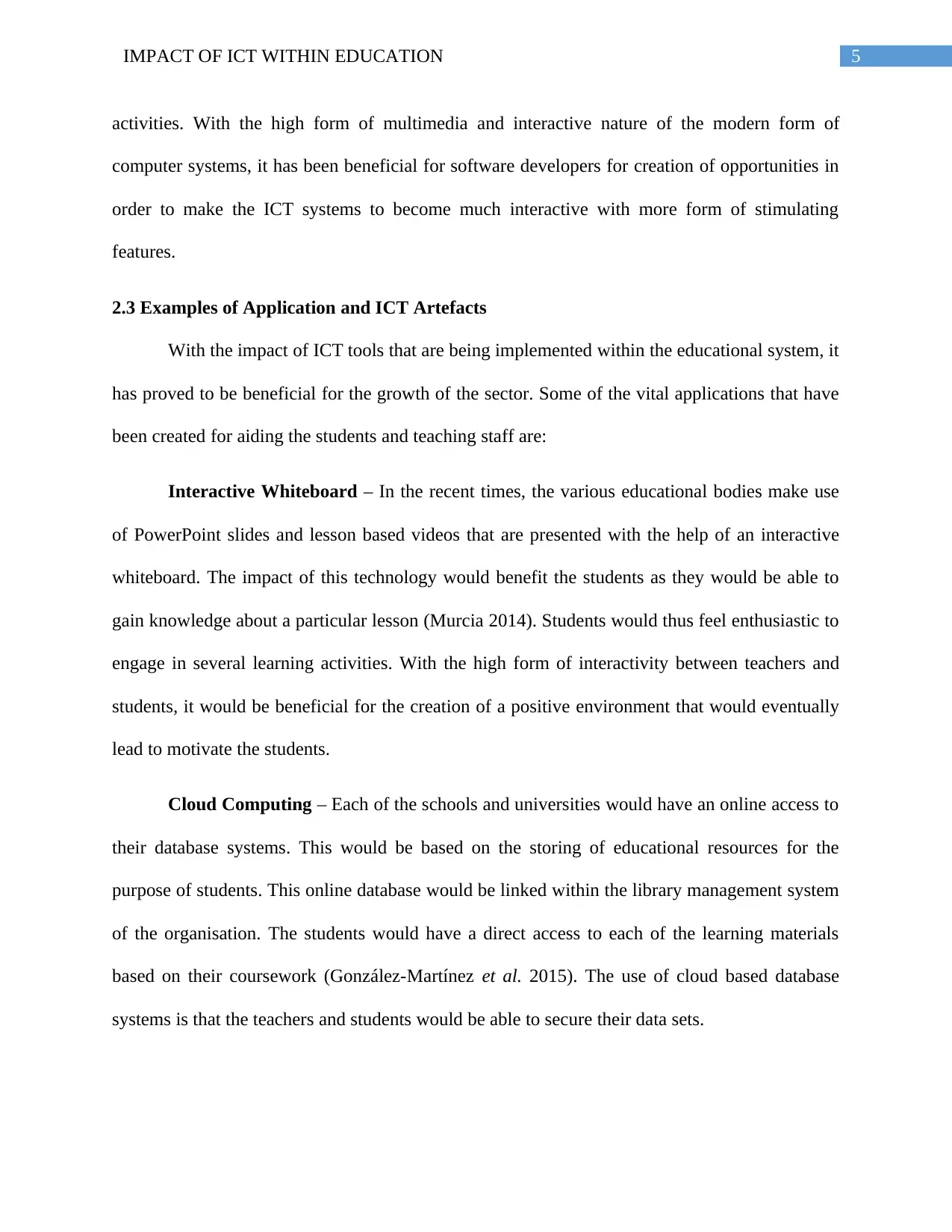
5IMPACT OF ICT WITHIN EDUCATION
activities. With the high form of multimedia and interactive nature of the modern form of
computer systems, it has been beneficial for software developers for creation of opportunities in
order to make the ICT systems to become much interactive with more form of stimulating
features.
2.3 Examples of Application and ICT Artefacts
With the impact of ICT tools that are being implemented within the educational system, it
has proved to be beneficial for the growth of the sector. Some of the vital applications that have
been created for aiding the students and teaching staff are:
Interactive Whiteboard – In the recent times, the various educational bodies make use
of PowerPoint slides and lesson based videos that are presented with the help of an interactive
whiteboard. The impact of this technology would benefit the students as they would be able to
gain knowledge about a particular lesson (Murcia 2014). Students would thus feel enthusiastic to
engage in several learning activities. With the high form of interactivity between teachers and
students, it would be beneficial for the creation of a positive environment that would eventually
lead to motivate the students.
Cloud Computing – Each of the schools and universities would have an online access to
their database systems. This would be based on the storing of educational resources for the
purpose of students. This online database would be linked within the library management system
of the organisation. The students would have a direct access to each of the learning materials
based on their coursework (González-Martínez et al. 2015). The use of cloud based database
systems is that the teachers and students would be able to secure their data sets.
activities. With the high form of multimedia and interactive nature of the modern form of
computer systems, it has been beneficial for software developers for creation of opportunities in
order to make the ICT systems to become much interactive with more form of stimulating
features.
2.3 Examples of Application and ICT Artefacts
With the impact of ICT tools that are being implemented within the educational system, it
has proved to be beneficial for the growth of the sector. Some of the vital applications that have
been created for aiding the students and teaching staff are:
Interactive Whiteboard – In the recent times, the various educational bodies make use
of PowerPoint slides and lesson based videos that are presented with the help of an interactive
whiteboard. The impact of this technology would benefit the students as they would be able to
gain knowledge about a particular lesson (Murcia 2014). Students would thus feel enthusiastic to
engage in several learning activities. With the high form of interactivity between teachers and
students, it would be beneficial for the creation of a positive environment that would eventually
lead to motivate the students.
Cloud Computing – Each of the schools and universities would have an online access to
their database systems. This would be based on the storing of educational resources for the
purpose of students. This online database would be linked within the library management system
of the organisation. The students would have a direct access to each of the learning materials
based on their coursework (González-Martínez et al. 2015). The use of cloud based database
systems is that the teachers and students would be able to secure their data sets.
⊘ This is a preview!⊘
Do you want full access?
Subscribe today to unlock all pages.

Trusted by 1+ million students worldwide
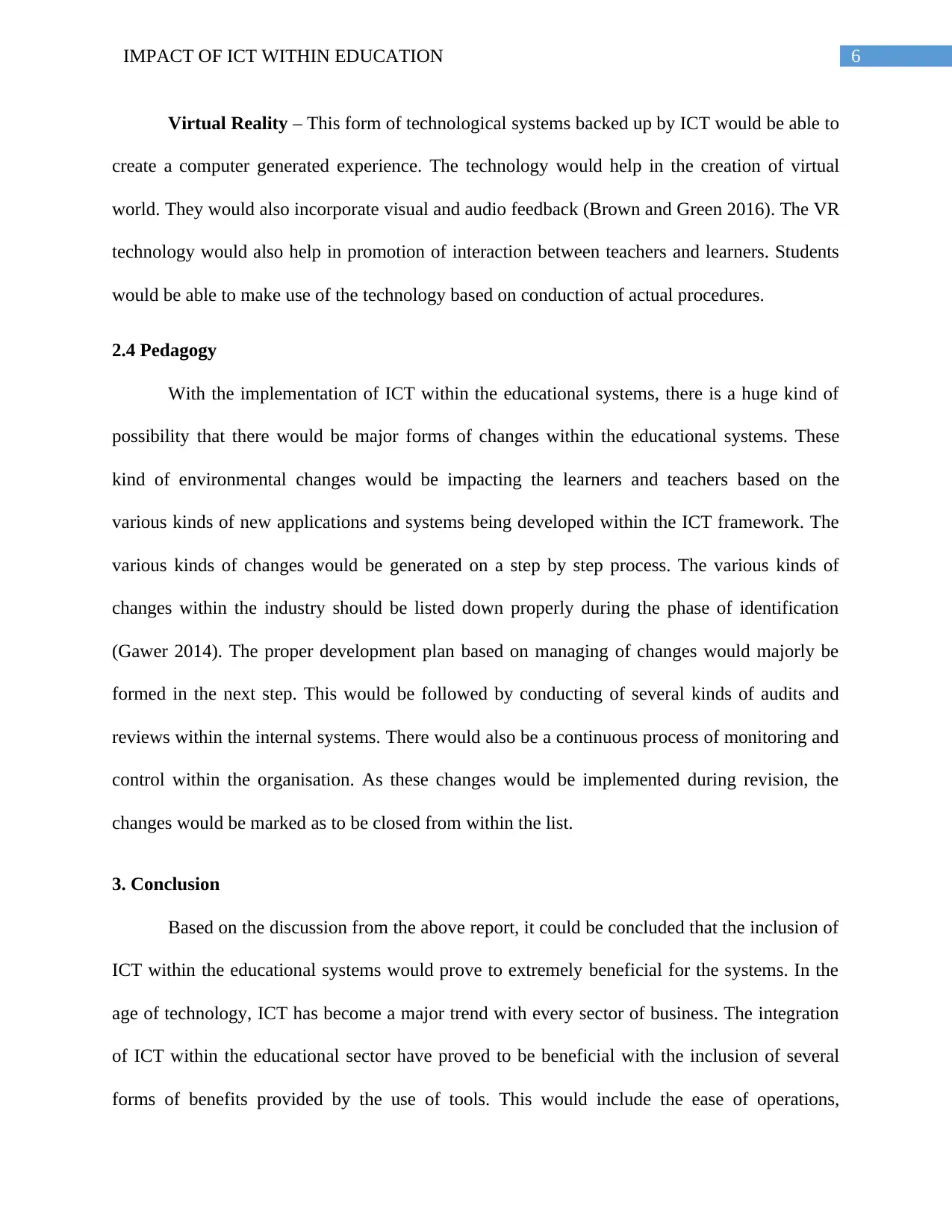
6IMPACT OF ICT WITHIN EDUCATION
Virtual Reality – This form of technological systems backed up by ICT would be able to
create a computer generated experience. The technology would help in the creation of virtual
world. They would also incorporate visual and audio feedback (Brown and Green 2016). The VR
technology would also help in promotion of interaction between teachers and learners. Students
would be able to make use of the technology based on conduction of actual procedures.
2.4 Pedagogy
With the implementation of ICT within the educational systems, there is a huge kind of
possibility that there would be major forms of changes within the educational systems. These
kind of environmental changes would be impacting the learners and teachers based on the
various kinds of new applications and systems being developed within the ICT framework. The
various kinds of changes would be generated on a step by step process. The various kinds of
changes within the industry should be listed down properly during the phase of identification
(Gawer 2014). The proper development plan based on managing of changes would majorly be
formed in the next step. This would be followed by conducting of several kinds of audits and
reviews within the internal systems. There would also be a continuous process of monitoring and
control within the organisation. As these changes would be implemented during revision, the
changes would be marked as to be closed from within the list.
3. Conclusion
Based on the discussion from the above report, it could be concluded that the inclusion of
ICT within the educational systems would prove to extremely beneficial for the systems. In the
age of technology, ICT has become a major trend with every sector of business. The integration
of ICT within the educational sector have proved to be beneficial with the inclusion of several
forms of benefits provided by the use of tools. This would include the ease of operations,
Virtual Reality – This form of technological systems backed up by ICT would be able to
create a computer generated experience. The technology would help in the creation of virtual
world. They would also incorporate visual and audio feedback (Brown and Green 2016). The VR
technology would also help in promotion of interaction between teachers and learners. Students
would be able to make use of the technology based on conduction of actual procedures.
2.4 Pedagogy
With the implementation of ICT within the educational systems, there is a huge kind of
possibility that there would be major forms of changes within the educational systems. These
kind of environmental changes would be impacting the learners and teachers based on the
various kinds of new applications and systems being developed within the ICT framework. The
various kinds of changes would be generated on a step by step process. The various kinds of
changes within the industry should be listed down properly during the phase of identification
(Gawer 2014). The proper development plan based on managing of changes would majorly be
formed in the next step. This would be followed by conducting of several kinds of audits and
reviews within the internal systems. There would also be a continuous process of monitoring and
control within the organisation. As these changes would be implemented during revision, the
changes would be marked as to be closed from within the list.
3. Conclusion
Based on the discussion from the above report, it could be concluded that the inclusion of
ICT within the educational systems would prove to extremely beneficial for the systems. In the
age of technology, ICT has become a major trend with every sector of business. The integration
of ICT within the educational sector have proved to be beneficial with the inclusion of several
forms of benefits provided by the use of tools. This would include the ease of operations,
Paraphrase This Document
Need a fresh take? Get an instant paraphrase of this document with our AI Paraphraser

7IMPACT OF ICT WITHIN EDUCATION
complexity reduction and enhancement of accuracy within the educational processes. Based on
the usage of such kind of technologies, it could be concluded that there is a major scope of
growth of ICT within the framework of educational sector.
complexity reduction and enhancement of accuracy within the educational processes. Based on
the usage of such kind of technologies, it could be concluded that there is a major scope of
growth of ICT within the framework of educational sector.
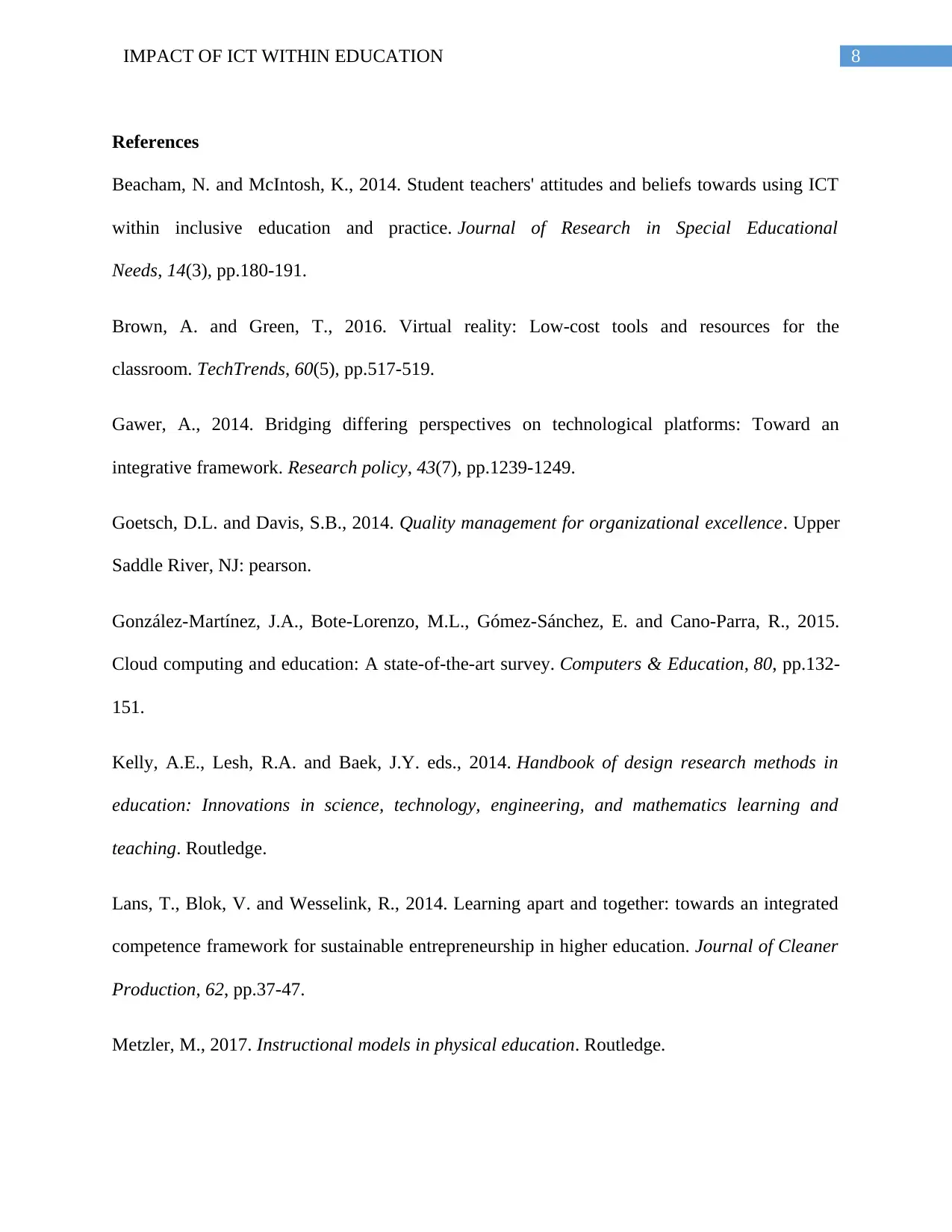
8IMPACT OF ICT WITHIN EDUCATION
References
Beacham, N. and McIntosh, K., 2014. Student teachers' attitudes and beliefs towards using ICT
within inclusive education and practice. Journal of Research in Special Educational
Needs, 14(3), pp.180-191.
Brown, A. and Green, T., 2016. Virtual reality: Low-cost tools and resources for the
classroom. TechTrends, 60(5), pp.517-519.
Gawer, A., 2014. Bridging differing perspectives on technological platforms: Toward an
integrative framework. Research policy, 43(7), pp.1239-1249.
Goetsch, D.L. and Davis, S.B., 2014. Quality management for organizational excellence. Upper
Saddle River, NJ: pearson.
González-Martínez, J.A., Bote-Lorenzo, M.L., Gómez-Sánchez, E. and Cano-Parra, R., 2015.
Cloud computing and education: A state-of-the-art survey. Computers & Education, 80, pp.132-
151.
Kelly, A.E., Lesh, R.A. and Baek, J.Y. eds., 2014. Handbook of design research methods in
education: Innovations in science, technology, engineering, and mathematics learning and
teaching. Routledge.
Lans, T., Blok, V. and Wesselink, R., 2014. Learning apart and together: towards an integrated
competence framework for sustainable entrepreneurship in higher education. Journal of Cleaner
Production, 62, pp.37-47.
Metzler, M., 2017. Instructional models in physical education. Routledge.
References
Beacham, N. and McIntosh, K., 2014. Student teachers' attitudes and beliefs towards using ICT
within inclusive education and practice. Journal of Research in Special Educational
Needs, 14(3), pp.180-191.
Brown, A. and Green, T., 2016. Virtual reality: Low-cost tools and resources for the
classroom. TechTrends, 60(5), pp.517-519.
Gawer, A., 2014. Bridging differing perspectives on technological platforms: Toward an
integrative framework. Research policy, 43(7), pp.1239-1249.
Goetsch, D.L. and Davis, S.B., 2014. Quality management for organizational excellence. Upper
Saddle River, NJ: pearson.
González-Martínez, J.A., Bote-Lorenzo, M.L., Gómez-Sánchez, E. and Cano-Parra, R., 2015.
Cloud computing and education: A state-of-the-art survey. Computers & Education, 80, pp.132-
151.
Kelly, A.E., Lesh, R.A. and Baek, J.Y. eds., 2014. Handbook of design research methods in
education: Innovations in science, technology, engineering, and mathematics learning and
teaching. Routledge.
Lans, T., Blok, V. and Wesselink, R., 2014. Learning apart and together: towards an integrated
competence framework for sustainable entrepreneurship in higher education. Journal of Cleaner
Production, 62, pp.37-47.
Metzler, M., 2017. Instructional models in physical education. Routledge.
⊘ This is a preview!⊘
Do you want full access?
Subscribe today to unlock all pages.

Trusted by 1+ million students worldwide
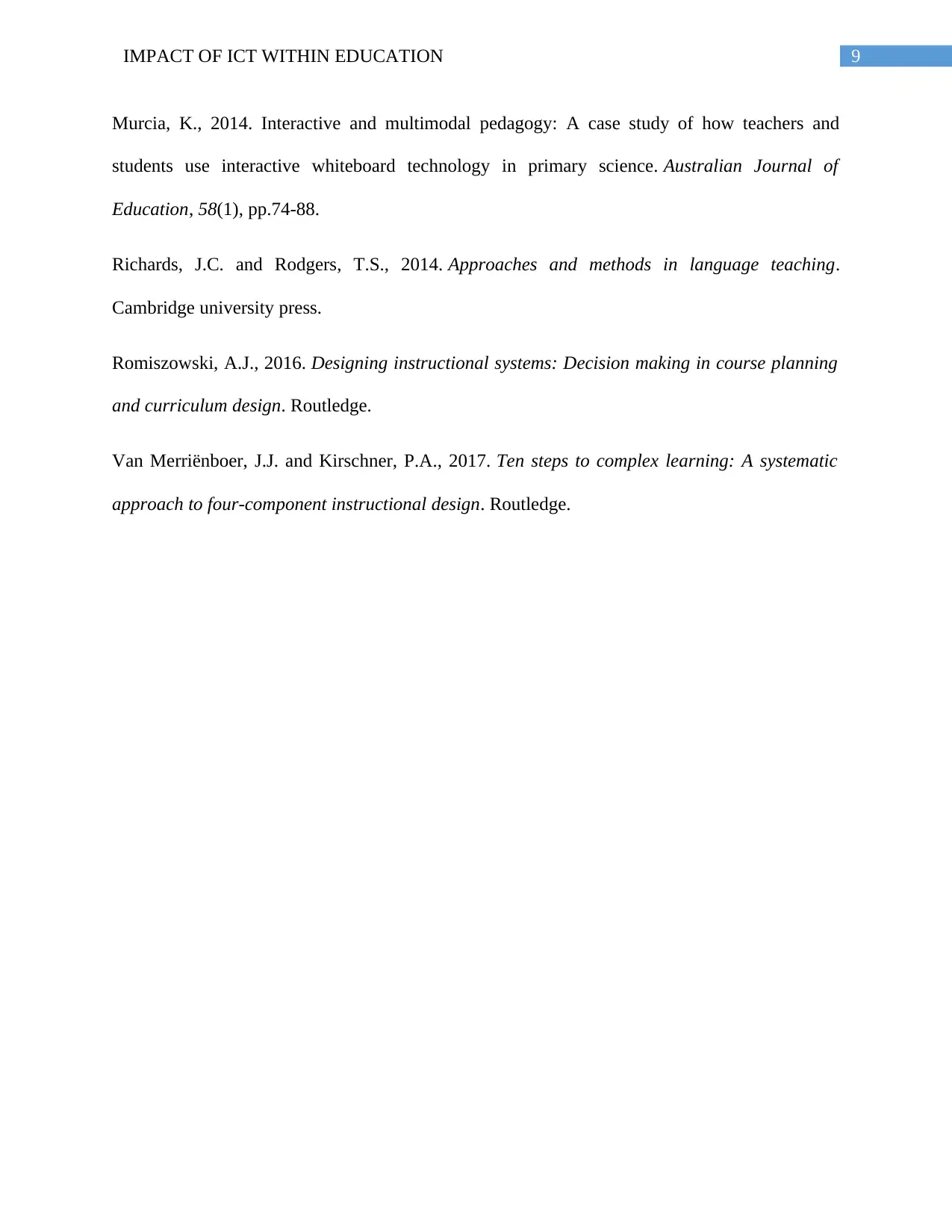
9IMPACT OF ICT WITHIN EDUCATION
Murcia, K., 2014. Interactive and multimodal pedagogy: A case study of how teachers and
students use interactive whiteboard technology in primary science. Australian Journal of
Education, 58(1), pp.74-88.
Richards, J.C. and Rodgers, T.S., 2014. Approaches and methods in language teaching.
Cambridge university press.
Romiszowski, A.J., 2016. Designing instructional systems: Decision making in course planning
and curriculum design. Routledge.
Van Merriënboer, J.J. and Kirschner, P.A., 2017. Ten steps to complex learning: A systematic
approach to four-component instructional design. Routledge.
Murcia, K., 2014. Interactive and multimodal pedagogy: A case study of how teachers and
students use interactive whiteboard technology in primary science. Australian Journal of
Education, 58(1), pp.74-88.
Richards, J.C. and Rodgers, T.S., 2014. Approaches and methods in language teaching.
Cambridge university press.
Romiszowski, A.J., 2016. Designing instructional systems: Decision making in course planning
and curriculum design. Routledge.
Van Merriënboer, J.J. and Kirschner, P.A., 2017. Ten steps to complex learning: A systematic
approach to four-component instructional design. Routledge.
1 out of 10
Related Documents
Your All-in-One AI-Powered Toolkit for Academic Success.
+13062052269
info@desklib.com
Available 24*7 on WhatsApp / Email
![[object Object]](/_next/static/media/star-bottom.7253800d.svg)
Unlock your academic potential
Copyright © 2020–2025 A2Z Services. All Rights Reserved. Developed and managed by ZUCOL.





